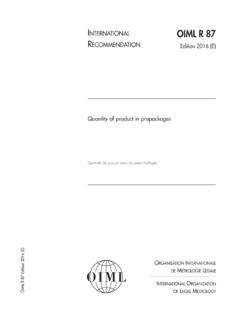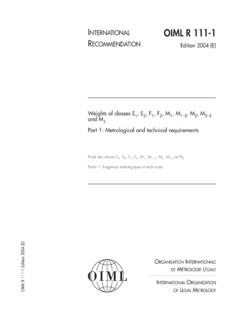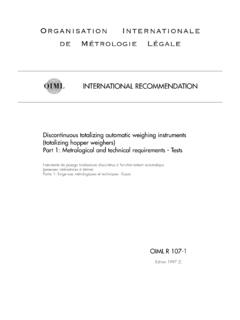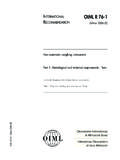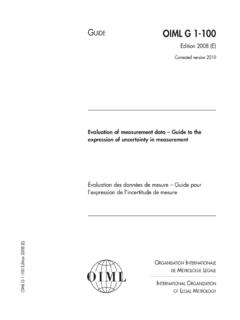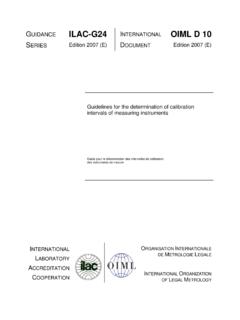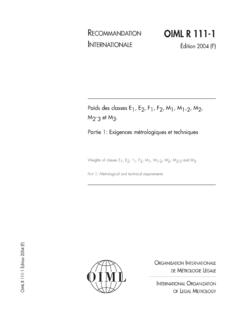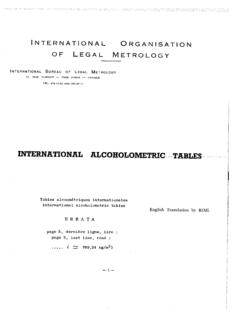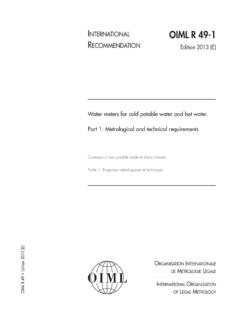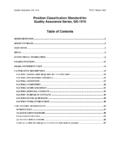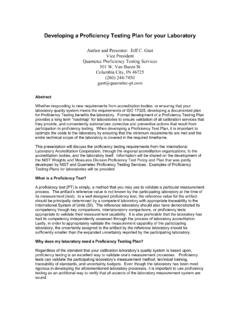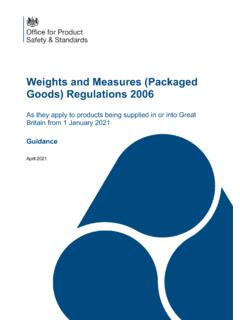Transcription of OIML R 111-1 (E) Edition 2004
1 Weights of classes E1, E2, F1, F2, M1, M1 2, M2, M2 3and M3 Part 1: Metrological and technical requirementsPoids des classes E1, E2, F1, F2, M1, M1 2, M2, M2 3et M3 Partie 1: Exigences m trologiques et techniquesOIML R 111-1 Edition 2004 (E)OIML R 111-1 Edition 2004 (E)ORGANISATIONINTERNATIONALEDEM TROLOGIEL GALEINTERNATIONALORGANIZATIONOFLEGALMETR OLOGYINTERNATIONALRECOMMENDATIONOIML R 111-1 : 2004 (E)2 Foreword .. 3 General .. 41 Scope .. 42 Terminology .. 53 Symbols .. 84 Units and nominal values for weights .. 11 Metrological requirements .. 115 Maximum permissible errors on verification .. 11 Technical requirements .. 136 Shape .. 137 Construction .. 148 Material .. 159 Magnetism .. 1610 Density .. 1711 Surface conditions .. 1812 Adjustment .. 1913 Marking .. 2014 Presentation .. 21 Metrological controls.
2 2215 Submission to metrological controls .. 2216 Control marking .. 23 Annex AExamples of different shapes and dimensions .. 25 Annex BTest procedures for weights .. Introduction .. Test sequence .. Document review and visual inspection .. Cleaning weights .. Surface roughness .. Magnetism .. Density .. Assignment of an OIML R 111 class to old and/or special weights .. 60 Annex CCalibration of a weight or weight set .. Scope .. General requirements .. Weighing designs .. Weighing cycles .. Data analysis .. Uncertainty calculations .. 66 Annex DStatistical control .. Check standard .. Precision of the balance .. 72 Annex ECIPM formula and an approximation formula .. CIPM formula .. Constants.
3 Approximation formula for air density .. 76 References .. 77 ContentsOIML R 111-1 : 2004 (E)3 The International Organization of legal metrology (OIML) is a worldwide, intergovernmental organizationwhose primary aim is to harmonize the regulations andmetrological controls applied by the national metrologicalservices, or related organizations, of its Member two main categories of OIML publications are: International Recommendations (OIML R), which aremodel regulations that establish the metrological charac-teristics required of certain measuring instruments andwhich specify methods and equipment for checking theirconformity; the OIML Member States shall implementthese Recommendations to the greatest possible extent; International Documents (OIML D), which are inform-ative in nature and intended to improve the work of themetrology Draft Recommendations and Documents are devel-oped by technical committees or subcommittees which areformed by Member States.
4 Certain international and regionalinstitutions also participate on a consultation agreements are established between OIML andcertain institutions, such as ISO and IEC, with the objectiveof avoiding contradictory requirements; consequently, manu-facturers and users of measuring instruments, test labor-atories, etc. may apply simultaneously OIML publicationsand those of other Recommendations and International Docu-ments are published in French (F) and English (E) and aresubject to periodic publication - OIML R 111-1 , Edition 2004 (E) - wasdeveloped by TC 9/SC 3 Weights. It was directly sanctioned bythe International Conference of legal metrology in Publications may be downloaded from the OIML website in the form of PDF files. Additional information onOIML Publications may be obtained from the Organization sheadquarters:Bureau International de M trologie L gale11, rue Turgot - 75009 Paris - FranceTelephone: 33 (0)1 48 78 12 82 Fax:33 (0)1 42 82 17 R 111-1 : 2004 (E)4 Weights of classes E1, E2, F1, F2, M1, M1 2, M2, M2 3and Recommendation contains technical ( principal physical characteristics) and metrological re-quirements for weights used: As standards for the verification of weighing instruments; As standards for the verification or calibration of weights of a lower accuracy class.
5 With weighing Recommendation applies to weights with nominal values of mass from 1 mg to 5 000 kg in the E1, E2, F1, F2,M1, M1 2, M2, M2 3and M3 accuracy accuracy class of weightsThe accuracy class for weights used as standards for the verification of weights or weighing instruments should bein accordance with the requirements of the relevant OIML OIML weight classes are defined as follows:Class E1:Weights intended to ensure traceability between national mass standards (with values derivedfrom the International Prototype of the kilogram) and weights of class E2and lower. Class E1weights or weight sets shall be accompanied by a calibration certificate (see ).Class E2:Weights intended for use in the verification or calibration of class F1weights and for use withweighing instruments of special accuracy class I.
6 Class E2weights or weight sets shall be accom-panied by a calibration certificate (see ). They may be used as class E1weights if they com-ply with the requirements for surface roughness, magnetic susceptibility and magnetization forclass E1weights, and if their calibration certificate gives the appropriate data as specified F1:Weights intended for use in the verification or calibration of class F2 weights and for use withweighing instruments of special accuracy class I and high accuracy class F2:Weights intended for use in the verification or calibration of class M1and possibly class M2weights. Also intended for use in important commercial transactions ( precious metals andstones) on weighing instruments of high accuracy class M1:Weights intended for use in the verification or calibration of class M2weights, and for use withweighing instruments of medium accuracy class M2:Weights intended for use in the verification or calibration of class M3weights and for use in gener-al commercial transactions and with weighing instruments of medium accuracy class M3:Weights intended for use with weighing instruments of medium accuracy class III and ordinaryaccuracy class M1 2 Weights from 50 kg to 5 000 kg of lower accuracy intended for use with weighing instruments of and M2 3:medium accuracy class.
7 The error in a weight used for the verification of a weighing instrument shall not exceed 1/3 of the maximum permissible er-ror for an instrument. These values are listed in section of OIML R 76 Nonautomatic Weighing Instruments(1992).OIML R 111-1 : 2004 (E)52 TERMINOLOGYThe terminology used in this Recommendation conforms to the International Vocabulary of Basic and GeneralTerms in metrology (1993 Edition ) [1] and the International Vocabulary of Terms in legal metrology (2000 Edition )[2]. In addition, for the purposes of this Recommendation, the following definitions classClass designation of a weight or weight set which meets certain metrological requirements intended to maintainthe mass values within specified indicating apparent mass that is sensitive to the following buoyancy equal to the weight of the displaced component of the magnetic interaction between the weight and the balance and/or the and Mare vectors.
8 Zis the vertical cartesian magnetic effects are negligible, the permanent magnetization (M) of the weight and the magnetic susceptibil-ity ( ) are sufficiently small, and the balance is calibrated with reference weights of well known mass, the balancecan be used to indicate the conventional mass, mc, of a body under conventionally chosen of operations that establish, under specified conditions, the relationship between values of quantities indicatedby a measuring instrument or measuring system, or values represented by a material measure or a reference mate-rial, and the corresponding values realized by 1:The result of a calibration permits either assignment of values of measurands to the indications or the determination of cor-rections with respect to 2:A calibration may also determine other metrological properties such as the effect of influence 3:The result of a calibration may be recorded in a document, sometimes called calibration certificate or calibration certificate (report)Certificate issued only by authorized or accredited laboratories that record the results of a of conformityDocument provided by the national responsible body indicating confidence that an identified weight or weight set,or samples thereof, is in conformity with the relevant requirements of this Recommendation (see OIML CertificateSystem for Measuring Instruments).
9 StandardStandard that is used in a statistical control process to provide a check to ensure that standards, measurementprocesses and results are within acceptable statistical of measurement based on comparing the value of a quantity to be measured with a known value of thesame R 111-1 : 2004 (E) mass(also called the conventional value of mass)Conventional value of the result of weighing in air, in accordance with OIML D 28 Conventional value of the resultof weighing in air[3]. For a weight taken at a reference temperature (tref) of 20 C, the conventional mass is themass of a reference weight of a density ( ref) of 8 000 kg m 3which it balances in air of a reference density ( 0) kg m of a bodyMass divided by volume, given by the that generates an attractive or repulsive dipole moment(md)Parameter of a magnetic dipole.
10 The magnetic field strength generated by a dipole, also the force between the di-pole and a magnetized sample, is proportional to this dipole moment. The force between the dipole and a samplehaving a magnetic susceptibility is proportional to the square of the dipole field strength(H)Local magnetic intensity, generated by magnetic material, such as a permanent magnet, or by electrical force(F1, F2, Fa, Fb, Fmaxand Fz)Force produced on magnetic or magnetically susceptible material by external magnetic permeability( )Measure of the ability of a medium to modify a magnetic constant(magnetic permeability of vacuum ( 0)) 0=4 10 7NA (Volume) magnetic susceptibility( )Measure of the ability of a medium to modify a magnetic field. It is related to the magnetic permeability ( ) by therelation: / 0= 1+ . The quantity / 0is sometimes referred to as the relative permeability, (Permanent) magnetization(M)Parameter that specifies a magnetic state of material bodies such as weights, in the absence of an external magnet-ic field (most generally, magnetization is a vector whose magnitude and direction are not necessarily constantwithin the material).
